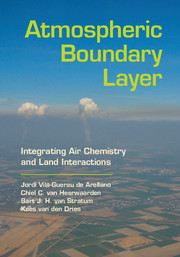Book contents
- Frontmatter
- Contents
- CLASS Software
- Preface
- Acknowledgments
- Part I The Land-Atmospheric Boundary Layer System
- Part II The Uncoupled System
- 2 Atmospheric Boundary Layer Dynamics
- 3 Atmospheric Boundary Layer Chemistry
- 4 Potential Temperature Budget: Diurnal Variation of Temperature
- 5 Moisture Budget: Diurnal Variation of Specific Moisture
- 6 Momentum Budget: Diurnal Variation of Wind
- 7 Scalar and CO2 Budget: Contributions of Surface, Entrainment, and Advection
- 8 Reactant Budget: Diurnal Variation of Ozone
- Part III The Coupled System
- Part IV Processes Related to Boundary Layer Clouds
- Part V User's Guide: CLASS Modules and Variables
- Appendices
- Bibliography
- Index
2 - Atmospheric Boundary Layer Dynamics
from Part II - The Uncoupled System
Published online by Cambridge University Press: 05 July 2015
- Frontmatter
- Contents
- CLASS Software
- Preface
- Acknowledgments
- Part I The Land-Atmospheric Boundary Layer System
- Part II The Uncoupled System
- 2 Atmospheric Boundary Layer Dynamics
- 3 Atmospheric Boundary Layer Chemistry
- 4 Potential Temperature Budget: Diurnal Variation of Temperature
- 5 Moisture Budget: Diurnal Variation of Specific Moisture
- 6 Momentum Budget: Diurnal Variation of Wind
- 7 Scalar and CO2 Budget: Contributions of Surface, Entrainment, and Advection
- 8 Reactant Budget: Diurnal Variation of Ozone
- Part III The Coupled System
- Part IV Processes Related to Boundary Layer Clouds
- Part V User's Guide: CLASS Modules and Variables
- Appendices
- Bibliography
- Index
Summary
We first describe the main characteristics of the diurnal atmospheric boundary layer (ABL), thus paving the way for introducing the main physical laws that govern the thermodynamic variables and concentrations of atmospheric constituents. The mathematical expressions based on the physical laws are introduced and the main assumptions employed in designing the dynamics of the model are explained. Particular emphasis is laid on showing how the key characteristics of the ABL are retained in the mathematical framework and on interpreting the physical implications of the governing equations.
Physical Description
Our focus is on the understanding and representation of the diurnal atmospheric boundary layer, namely, the convective boundary layer (CBL). Roughly speaking, this layer, which is in direct contact with the surface, develops from sunrise and lasts until sunset. As Figure 2.1 sketches, it is characterized by a strong diurnal variability, in that it grows from a few hundred meters in depth in the early morning to more than one kilometer in the afternoon. Although the nocturnal conditions, the so-called stable boundary layer in the ABL, are not explicitly treated, we will learn that these conditions still strongly influence the processes and conditions that occur during the day and that they can be implicitly incorporated in our studies.
In a CBL the turbulent flow is driven by buoyancy. Light rising air from the surface organizes itself into thermal plumes or eddies, which can occupy substantial areas (diameters of up to 1 km) and reach the top of the boundary layer. As an illustration of the characteristics and structure of the thermals, we show in Figure 2.2 (left panel) a simulation of the spatial distribution of water vapor in a convective boundary layer produced by a large eddy simulation. The thermals are transporting moisture upward (blue) and are surrounded by downward motions of dry air (red) entrained from the free troposphere. These plumes mix air from the surface to the top of the boundary layer and thereby create a well-mixed layer.
- Type
- Chapter
- Information
- Atmospheric Boundary LayerIntegrating Air Chemistry and Land Interactions, pp. 21 - 32Publisher: Cambridge University PressPrint publication year: 2015



